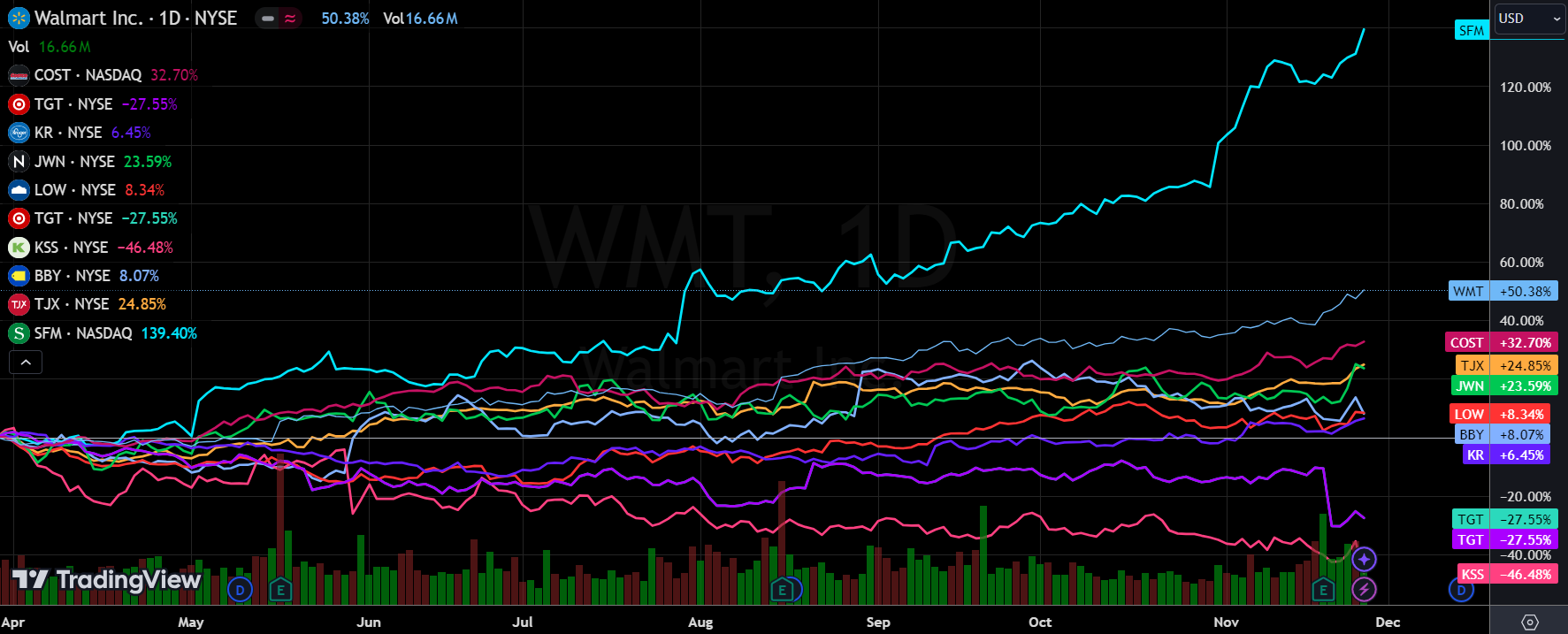Divergence in supermarkets in Q3, who's the biggest winner?
The sector with the biggest difference this quarter might be the retail superstore, specifically looking at a few characteristics:.
The headline membership hypermarket $Wal-Mart(WMT)$ $Costco(COST)$ is riding high, far outperforming the rest of its peers in terms of member retention, e-commerce development, supply chain management, or category dominance, and the impact brought by its international business, and as a result, its stock price iscontinue to reach record highs;
Tier 2 superstores, $Target(TGT)$ recovered after an inflationary period of blowback, but once again, the stock crashed and plummeted this quarter after an embarrassing quarter of across-the-board earnings misses and guidance downgrades;
Discounters have been relatively steady performers, both in essential and optional consumer goods, continuing to maintain market share due to low prices and a stable audience in lower income groups $TJX Companies(TJX)$
In terms of specific performance, the optional consumer goods category performed a bit worse, with relatively less spending on entertainment, appliances, etc., resulting in the performance of superstores that are dominant in these categories being more likely to crash and burn; while the performance of superstores that are relatively dominant in categories of essential goods, such as food, was relatively better $Sprouts Farmers(SFM)$ ,who performs more than 200%+YTD. While the furniture category, on the other hand, has shown more rate sensitivity $Lowe's(LOW)$ $Home Depot(HD)$
In addition, superstores with better memberships and e-commerce have gained better results and expanded their market share $Amazon.com(AMZN)$ $Costco(COST)$ $Wal-Mart(WMT)$
On November 26, both category superstores BBY and KSS reported Q3 results that were very disappointing to investors.
BBY $ Best Buy (BBY)$
Best Buy reported revenues of $9.45 billion in Q3 of fiscal 2025, down 2.9% year-over-year, a decline slightly above market expectations of 1%.Adjusted earnings per share came in at $1.26, compared to the market's estimate of $1.29.
Business Performance by Category
Appliances: Sales in the appliance category declined 14.7%, well below expectations of 7.5%.This decline was largely driven by lower consumer spending and economic uncertainty.
Recreational Products: Sales of recreational products declined even more sharply, by 18.8%, indicating a weakening of consumers' willingness to purchase non-essential items.
Computers and Cell Phones: In relative terms, the computers and cell phones category grew by 3.8%, driven by increased consumer demand during the upgrade and replacement cycle.
Service revenues: service revenues grew 6%, exceeding expectations and demonstrating the Company's success in providing value-added services
Analysis of Reasons for Difference in Performance from Expectations
Macroeconomic uncertainty, consumers' wait for discounts, and pre-election uncertainty all contributed to lower than expected demand.24 Additionally, overall sales were impacted by a significant reduction in consumer spending on non-essential categories.Nonetheless, the company responded to these challenges by launching holiday promotions early and optimizing the customer experience.
KSS $ Kohl's Stores (KSS)$
Key Financial Indicators
Net sales: $3.51 billion ($3.64 billion expected), with comparable sales down 9.3% year-over-year
Earnings per share: $0.20 (year-ago: $0.53)
Net income: $22 million (year-ago: $59 million)
Despite the decline in sales, Kohl's saw an increase in gross margin to 39.1%, up 20 basis points from last year.Selling, general and administrative (SG&A) expenses declined 5.1% year-over-year to $1.3 billion, or 34.8% of total revenues
Apparel and footwear: Weak sales were the primary reason for the overall decline.
New store openings: 200 new Babies 'R' Us stores were opened, but the overall impact was limited.
Analysis of Reasons for Difference in Performance from Expectations
The main reasons for Kohl's performance missing expectations include the following:
Weak consumer spending: Consumer spending on apparel and footwear decreased significantly due to economic uncertainty and inflationary pressures.
Increased competition: The retail industry is becoming increasingly competitive, especially in the run-up to the holiday season, with Kohl's facing strong pressure from other retailers and e-commerce platforms.
Inventory management: Despite a 3% year-over-year decline in inventory, inventory turns need to be improved to respond to rapidly changing consumer demand
Disclaimer: Investing carries risk. This is not financial advice. The above content should not be regarded as an offer, recommendation, or solicitation on acquiring or disposing of any financial products, any associated discussions, comments, or posts by author or other users should not be considered as such either. It is solely for general information purpose only, which does not consider your own investment objectives, financial situations or needs. TTM assumes no responsibility or warranty for the accuracy and completeness of the information, investors should do their own research and may seek professional advice before investing.


very detailed analysis, looking for more 🙌